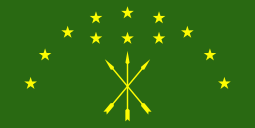 The village of Mafekhabl, which was founded by the Kosovo Circassians who returned to the Caucasus | |
| Total population | |
| 40,000 (1870)[1] 6,400 (1890)[2] 200 (1998) | |
| Languages | |
| Circassian, Albanian | |
| Religion | |
| Sunni Islam | |
| Related ethnic groups | |
| Other Circassians |
| Part of a series on the |
| Circassians Адыгэхэр |
|---|
 List of notable Circassians Circassian genocide |
| Circassian diaspora |
| Circassian tribes |
|
Surviving Destroyed or barely existing |
| Religion |
|
Religion in Circassia |
| Languages and dialects |
|
| History |
|
Show |
| Culture |
The Circassians in Kosovo (Adyghe: Косовам ис Адыгэхэр, romanized: Kosovam yis Adıgəxər; Albanian: Çerkezët në Kosovë; Serbian: Черкези на Косову) were a group of the Circassian people who lived in Kosovo beginning in the mid-19th century, when they were exiled during the Circassian genocide to the Ottoman Empire after the Russo-Circassian War. During this time, the Circassians in Kosovo were from three of the twelve Adyghe tribes: the Abzakh, Shapsug and Ubykh.[3] In 1998 they numbered 200.
History
Arrival in Kosovo
After the Circassian genocide following the Russo-Circassian War, large number of Circassians were exiled to the Ottoman Empire, including in Kosovo.[1] Between 1858 and 1862, 6,000 Circassian families settled in Kosovo.[1][4] Other Circassians were settled in Niš and Prokuplje between 1862 and 1863.[1][5] Around 12,000 Circassians were once again sent to Kosovo and Serbia in following months.[1][6] In total, 40,000 Circassians were settled in Kosovo alone.[7]
The Ottoman Empire aimed to make life easier for the newly arrived Circassians, and did not tax them and they were provided with materials to farm with.[1][2] The Circassians were not well received by both Albanians and Serbs.[8] Both Albanians and Serbs considered the Circassians to be wild and primitive Barbarians.[8] People of the Kosovo region as well as some regional governors helped Circassians.[1][9][10] Since there was no mosque in Babimusa, where more than 200 Circassian families were settled, the local administration started to work on the construction of a mosque at the end of 1864.[1][11]
Decrease in population
Majority leaving the region (1877–1878)
The Circassians in Bulgaria fiercely opposed the Bulgarian Revolt in 1876. Kosovo Circassians also joined the Bulgarian Circassians.[1][2] European countries in turn demanded that the Circassians leave the region.[12]
Circassians sided with the Turkish army during the Russo-Turkish War (1877–1878).[2] After the war, the Circassians were seen as a "Muslim threat" and expelled from Kosovo, Bulgaria and other parts of the Balkans by Russian armies following the end of the Russo-Turkish war. They were not allowed to return,[13][14] so the Ottoman authorities settled them in new other lands such as in modern Jordan (see Circassians in Jordan), where they would have conflict with Bedouin Arabs,[15] and Turkey (see Circassians in Turkey).[16]
Last remnants leaving for Adygea (1998-1999)
When the Kosovo War began, the Circassians in Kosovo emigrated to their ancestral homeland, Republic of Adygea, where they founded a village named Mafekhabl near the republic's capital of Maykop.[17] Muammar Gaddafi sent support and donations to the village. Gaddafi, according to his own words, showed a deep respect for the Circassians and their historical suffering.[18]
Known families
Below is a list of some of the Circassian families who live or have lived in Kosovo.[19]
References
- 1 2 3 4 5 6 7 8 9 Urhan, Vahit Cemil. "Kosova'ya Yapılan Çerkes Göçü ve İskânı (1864-1865)". Trakya Üniversitesi, Balkan Araştırma Enstitüsü.
- 1 2 3 4 Noel Malcolm, Kosova: Balkanları Anlamak İçin, çev. Özden Arıkan, Sabah Kitapları, İstanbul 1999
- ↑ "The Circassians in Kosovo". www.circassianworld.com. Archived from the original on 9 December 2021. Retrieved 9 December 2021.
- ↑ Jusuf Osmani, Çerkezët në Kosovë, Olymp, Prishtinë 2014, p. 40.
- ↑ Jusuf Osmani, Çerkezët në Kosovë, Olymp, Prishtinë 2014, p. 26.
- ↑ Takvîm-i Vekâyi, 1 Ağustos 1864, No: 759, s. 1.
- ↑ Jusuf Osmani, Çerkezët në Kosovë, Olymp, Prishtinë 2014, p. 21, 26, 40.
- 1 2 Devolli, Blendi (30 July 2016). "Viktimat e gjenocidit rus, që gjetën shpëtim edhe në Kosovë: Çerkezët, populli i bukur sykaltër (Foto) - Telegrafi". Retrieved 17 September 2023.
- ↑ Turkish archives: BOA, A.}MKT.MHM. 314-100 1281.Ca.15 (16.10.1864).
- ↑ Yücel Yiğit, "Kosova Çerkezleri", Geçmişten Günümüze Göç III, ed. Osman Köse, Canik Belediyesi Kültür Yayınları, Samsun 2017, s. 2177.
- ↑ Turkish archives: BOA, İ..DH.. 534-37022-1 1281.C.05 (05.11.1864); BOA, İ..DH.. 534-37022-2 1281.Ş.16 (14.01.1865); BOA, İ..DH.. 534-37022-3 1281.Ş.29 (28.01.1865); BOA, İ..DH.. 534-37022-4 1281.N.22 (18.02.1865); BOA, İ..DH.. 534-37022-5 1281.L.07 (05.03.1865); BOA, A.}MKT. MHM. 326-86 1281.L.15 (13.03.1865). Babimusa adı bir belgede Babinmusa olarak geçmektedir. BOA, İ..DH.. 534-37022-1 1281.C.05 (05.11.1864).
- ↑ İsmail Hakkı Uzunçarşılı,"Tersane Konferansının Mukarreratı Hakkında Şûra Mazbatası", İstanbul Üniversitesi Edebiyat Fakültesi Tarih Dergisi, VI/9 (1954), s. 125., Dipnot: 2.
- ↑ Hacısalihoğlu, Mehmet. Kafkasya'da Rus Kolonizasyonu, Savaş ve Sürgün (PDF). Yıldız Teknik Üniversitesi.
- ↑ BOA, HR. SYS. 1219/5, lef 28, p. 4
- ↑ Walker, A. (September 1894). "The Circassian colonies at Amman and Jerash". The Biblical World. 4 (3): 202–204. doi:10.1086/471510. S2CID 144986180.
- ↑ Natho, Kadir I. Circassian History.
- ↑ "Европейский суд по правам человека - жалобы - Аул, которого нет". Espch.ru. Archived from the original on 22 February 2012. Retrieved 6 February 2019.
- ↑ Al- Shishani, Murad Batal. Qaddafi Tries to Secure Loyalty of Circassians of Misrata
- ↑ "Где жили косовские адыги до переселения?". 9 July 2021.
